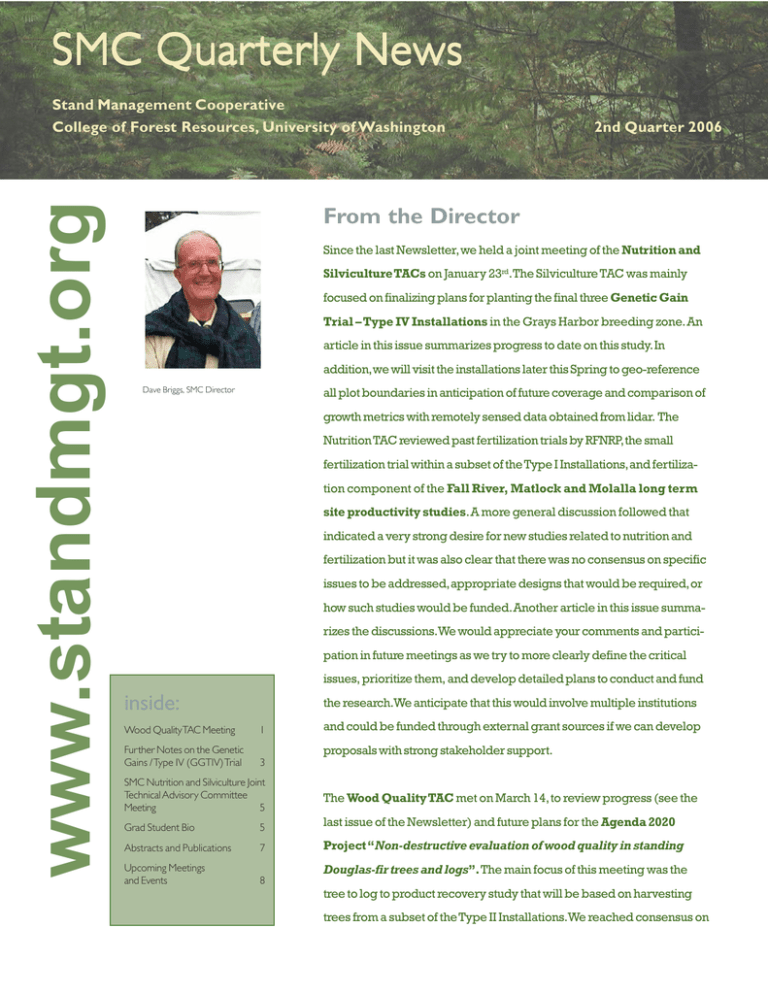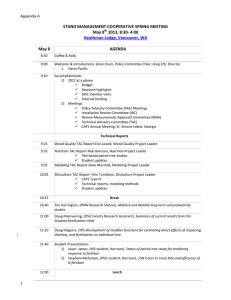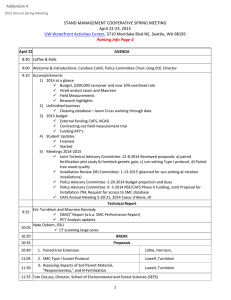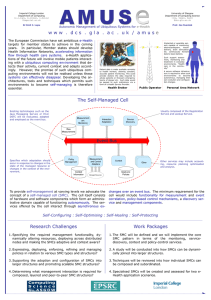SMC Quar ter y News SMC Quar ter
advertisement

SMC Quar ter ly News www.standmgt.org Stand Management Cooperative College of Forest Resources, University of Washington 2nd Quarter 2006 From the Director Since the last Newsletter, we held a joint meeting of the Nutrition and Silviculture TACs on January 23rd. The Silviculture TAC was mainly focused on finalizing plans for planting the final three Genetic Gain Trial – Type IV Installations in the Grays Harbor breeding zone. An article in this issue summarizes progress to date on this study. In addition, we will visit the installations later this Spring to geo-reference all plot boundaries in anticipation of future coverage and comparison of Dave Briggs, SMC Director growth metrics with remotely sensed data obtained from lidar. The Nutrition TAC reviewed past fertilization trials by RFNRP, the small fertilization trial within a subset of the Type I Installations, and fertilization component of the Fall River, Matlock and Molalla long term site productivity studies. A more general discussion followed that indicated a very strong desire for new studies related to nutrition and fertilization but it was also clear that there was no consensus on specific issues to be addressed, appropriate designs that would be required, or how such studies would be funded. Another article in this issue summarizes the discussions.We would appreciate your comments and participation in future meetings as we try to more clearly define the critical issues, prioritize them, and develop detailed plans to conduct and fund inside: the research.We anticipate that this would involve multiple institutions Wood QualityTAC Meeting 1 Further Notes on the Genetic Gains / Type IV (GGTIV) Trial 3 and could be funded through external grant sources if we can develop proposals with strong stakeholder support. SMC Nutrition and Silviculture Joint Technical Advisory Committee Meeting 5 The Wood Quality TAC met on March 14, to review progress (see the Grad Student Bio 5 last issue of the Newsletter) and future plans for the Agenda 2020 Abstracts and Publications 7 Project “Non-destructive evaluation of wood quality in standing Upcoming Meetings and Events 8 Douglas-fir trees and logs”. The main focus of this meeting was the tree to log to product recovery study that will be based on harvesting trees from a subset of the Type II Installations.We reached consensus on tree, log, and product sampling and measurement procedures. A detailed “field manual” for the study will be prepared for review. We also discussed the schedule for completing the study by the end of summer 2006 and we are now initiating contacts with proposed veneer and lumber mills and landowners to schedule logging and processing logistics. We also reviewed progress on a study that is examining recovery and value of lumber from bear damaged trees and had a discussion of input from the wood quality perspective for the Strategic Planning Committee meeting. The Strategic Planning Committee met on March 16. Previously, the Committee reviewed the existing suite of Installations and made recommendations regarding criteria as to when these might be dropped in the future. The Committee also reviewed the SMC Mission Statement and organizational structure and recommended that these should not be changed. These were discussed and approved by the Policy Committee. This meeting focused on the question of “what would members like to see the SMC accomplish over the next 5-10 years?” This was broken down into three general categories, 1) work that could be accomplished using information already being collected from existing installations and stored in the database, 2) additional information that we could collect from the existing installations that would be either immediately beneficial to members or which would accumulate important new data that could help attract future external grants, assist in developing better models and tools, etc., and 3) new initiatives that address important questions of members. We first listed a number of items within each category, went back through these to clarify their definition, discussed potential collaborations that might serve to develop detailed plans and proposals for each of them, and potential funding sources. This will be summarized for review and discussion at the Spring Meeting. In This Issue In addition to the articles noted above, this issue introduces a new PhD graduate student, Rapeepan Kantavichai, who is working with Dave Briggs on the Agenda 2020 Project “Non-destructive evaluation of wood quality in standing Douglas-fir trees and logs.” 2 Also in this issue note that the Western Forest Mensurationists meeting will be held on June 18-20 in Fortuna, California. Also we have included the itinerary for the 2006 Levels of Growing Stock (LOGS) Annual Meeting and Field Trip on July 11-13 in British Columbia. Finally, we hope to see you at the SMC Spring Meeting on April 26-27. We will be sending a detailed agenda in the near future. Fur ther Notes on the Genetic Gains / Type IV Further (GGTIV) Tr ial Eric C. Turnblom, SMC Silviculture Team Leader and Associate Professor UW David G. Briggs, SMC Director, Precision Forestry Co-op Director, and Professor, UW Introduction The genesis of these joint trials began with discussions between the Northwest Tree Improvement Cooperative (NWTIC), the Stand Management Cooperative (SMC), and other interested parties on how best to study the interactions between genetic improvements and silvicultural treatments. The SMC Type IV trials began to emerge as one possible way to accomplish this. The original Type IV design tackled four experimental factors: genetic gain level, spacing, vegetation control, and fertilization regime. That original design also covered 3 Douglas-fir and 3 western hemlock breeding zones west of the Cascades placing six installations within each breeding zone. Due to space limitations, logistical constraints, and further discussions with NWTIC, fertilization was dropped from the design and a single breeding zone was identified (Grays Harbor) to get things started. The resultant study essentially is one replication of the original six planned. The objectives of the GGTIV trials are twofold from the perspective of the SMC: 1) to provide information to guide managers currently applying combinations of genetics, spacing and vegetation control; and 2) to provide linkages with other studies (such as Genetic Gains Trials, intensive vegetation management trials, and spacing trials like the SMC Type III), that will assist modeling efforts. The NWTIC has recognized also the following objectives: 3) compare realized gains (per unit area basis) with predicted gains (individual tree basis), and 4) compare estimates of growth and yield parameters for populations with different expected growth potentials. The genetic gain factor has three levels: Unimproved, Intermediate gain (the SMC Type IV Trial portion does not use this intermediate level), and Elite gain. The spacing factor also has three levels: 15 x 15’, nominally 200 Stems Per Acre (SPA), 10 x 10’, nominally 440 SPA (Genetic Gain Trial portion uses this intermediate density only), and 7 x 7’, nominally 900 SPA. Finally, the vegetation control factor has two levels: Current Practice (defined as a single site prep; used only in SMC Type IV Trial portion and is consistent with SMC Type III practices), and Complete (defined as 80% or greater bare ground until crown closure; standard on all Genetic Gain Trial plots and on Type IV). These treatment combinations result in 22 plots total at a given site, with seven plots satisfying SMC objectives mainly, 13 plots mainly satisfying NWTIC objectives, and two plot types have shared objectives. 3 Progress to Date 2005 Installations (601, 602, 603) 603).. In mid-March 2005, installations 601 – Donkey Creek 2 (Ranonier), 602 – Donaldson Creek (Weyerhaeuser), and 603 – Crane Creek 2 (Quinalt) were all planted. In late June of last year, these installations were examined for survival. Survival rates were excellent, installation average being more than 99%. The worst survival at a single plot within an installation was 96%. At the fall 2005 Silviculture TAC meeting, further details were discussed and developed for tree measurement and vegetation monitoring protocols. Discussion led to the consensus that for those plots with full vegetation control prescribed, a pre-emergent herbicide should be applied to control competing vegetation even before it gets started. A tank mix has been prescribed in consultation with vegetation managers and contract foresters in the region and is ready to be applied to these installations within the next month. The first growing season survival survey was completed fall 2005. The fall survey results are as follows (installation average; five worst plots; five best plots): 601 – Donkey Creek 2 : 99; five worst: 95, 96, 97, 97, 97; five best: 99, 99, 99, 100, 100 602 – Donaldson Creek : 97; five worst: 90, 93, 93, 94, 95; five best: all 100% 603 – Crane Creek 2 : 99; five worst: 95, 96, 96, 98, 98; five best: all 100% As can be seen from these figures, survival is very high, and rather uniformly high at that. Of all 66 plots across all installations, 62, or 94% of the plots have a survival of 95% or better. Certainly, all the plots meet the minimum survival standard for Type III installations (90% or better). At the joint Siliviculture / Nutrition TAC meeting held at OSU, Corvallis, OR on 23 Jan 2006, the consensus reached previously at numerous TAC meetings that filler trees should not be planted was upheld. Adding filler trees, even if the same age, and even if the same genetic make-up, would produce an experimental unit that is treated unlike the rest, i.e., would have no true replicate in the study. This is particularly so in this case where we seek “per acre” yields as affected by silviculture and genetics. Full measurements will begin after the 2006 growing season. The measurement protocol, which found consensus at the autumn 2005 Silviculture TAC, is similar to the Type III protocol: On all trees: • • • 4 Measure height to nearest 0.1 foot using height pole until the average height is 15 feet; use laser instrument until average height is 30 ft. After 30 ft, measure height only on “intensive crown” trees. Measure diameter on each tree. Initially this will be basal caliper at a permanently marked 30cm point. After the tree reaches BH, dbh will be measured, as well, thereafter. Continue to measure basal caliper on each tree until 95% of trees on the plot reach breast height. Obtain BH age using whorl count and year of measurement STUDENT BIO On 42 “intensive crown” trees (sample chosen same as in Type IIIs): • • • Measure crown width in NS and EW directions Measure crown length, i.e., height to full crown base defined at that height at which ¾ of bole circumference contains live branches Total height to nearest 0.1 ft after average height is 30 ft. Rapeepan Kantavichai, Ph.D. candidate in Quantitative Resource Management, University of Washington, College of Forest Resources Vegetation monitoring protocol on SMC Type IV plots that received “standard” vegetation control is nearing completion. 2006 Installations (604, 605, 606) 606).. Five sites were proposed for planting this year by cooperators: two from Green Diamond Resource Co., two from WA DNR, and one from Port Blakely Tree Farms. A site tour was conducted on June 20, 2005, which led to the consensus that the three sites for planting in 2006 shall be 604 – Boxcar (WA DNR), 605 – Left Court (Port Blakely), and 606 – Wynoochee (Green Diamond). These installations have all been harvested, surveyed, prepped (peripheral piles scattered, moved and/or burned), sprayed, pinned and planted as of this writing. The pre-season survival bud break surveys are scheduled to be conducted in May/June 2006 at which point seedling cross numbers will be mapped by row and column designators. The first growing season survival survey will be conducted over the course of the regular SMC 2006 – 2007 measurement season and full measurement will commence after the 2007 growing season. Jan uar ition and Silviculture Januar uaryy 23: SMC Nutr Nutrition Joint Technical Advisor Advisoryy Committee Meeting Summary from Corvallis TAC meeting, January 23 1) RFNRP completed measurements of last phase in 1998 2) Fertilization is part of auxiliary plots on Type I Installations 3) extends RFNRP phase 4 (300 tpa) to variable density 4) Eric Sucre thesis (copies available) brings up questions 5) No fertilization done in Type II & III installations 6) No fertilization in Type IV installations 7) Type IV design became too complex & large, and lack of agreement on definition and focus if fertilization was included 8) Fall River, Matlock and Molalla LTSP studies include fertilization 9) Need for more studies I joined SMC in fall 2005, working under advice of Professor David Briggs. My interest is focused on biometric modeling and harvest system decision support concerned with productivity and economic efficiency. Currently I am working on effect of pre-commercial thinning, fertilization and initial stem density in Branch Diameter of Coastal US Douglas-fir plantations. I am also working on non-destructive evaluation of wood quality in standing Douglas-fir trees and logs project. I received undergraduate degree from Kasetsart University (Thailand) and master’s degree from University of Florida, both in Industrial Engineering. Prior joining SMC, I worked briefly as a project analyst in Thailand for 2 years. In my spare time, I enjoy skiing, running and cooking. The answer to #9 was “YES”, but no agreement on a specific design or where to find funding. The desire to start new fertilization studies is strong among many SMC members, and consensus has been pursued for a number of years, but not found. The SMC hasn’t started any significant new studies for two reasons. First, studies as done in the past on a scale able to answer regional questions would be very expensive…in the millions of dollars. For instance, between 1997 to the end of 2005, an estimated $3,004,000 was spent on characterization, treatments and research at Fall River, a complex study, but at a single site. 5 Currently, the desire of any new studies is not so much to know an average regional response, but to determine site specific responses. The ability to predict a more accurate response from the wide range of responses currently observed is critical to industry practicing fertilization on a larger scale. The proposal to combine LIDAR stand measurements and GIS and GPS for defining plots and aerial fertilization is still in development, but this has a great deal of promise for greatly reducing the cost of plot layout, fertilization and stand measurements. The SMC and PFC (Precision Forestry Cooperative) is currently pursuing “ground-truthing” LIDAR measurements of SMC studies to prove the ability or inability of LIDAR to substitute for most of the necessity for site visits for measurement. If this works out, then a proposal for a trial will be very quick. Several members have expressed desire to go ahead with some smaller-scale field fertilization trials. A lot of thinking and work went into designing the original RFNRP trials, and a lot of their design should be incorporated into a current design. For instance, Eric Sucre’s thesis research showed that current stand conditions are strong predictors of potential response to fertilization, as well as site variables. In the Southeast, LAI (leaf area index) has been shown to be a strong predictor of potential for response, and is currently being utilized. Unfortunately, LAI is not as easy to predict from remote sensing data in the PNW. Widespread application of LIDAR could change this, as LIDAR predicts LAI very well. As with the RFNRP, measuring a wide range of site variables that could be used to predict site and response to fertilization is also desired. This would include 1) Site index, age, slope, elevation, precipitation, C, N, P and K (%, weight and quality), exchangeable cations, CEC, pH, soil series type and horizon including depth, change relationships (i.e. nitrate adsorption), nutrient mineralization rates, and some other variables that might predict productivity and response. Based on previous research, nutrients applied must include N, preferably at several levels. SMC and other work has shown that both application rate at a given time and total application rate over time affect response. There is strong interest in additional nutrients, including P, S, Ca, K, Mg and B. Often, this has been approached by applying a “blend” of nutrients as a treatment (i.e. “George Fenn” prescriptions). It would be particularly important to understand non-response to N or any other nutrient in terms of a second or more nutrients. For instance, Figures 1 and 2 show applications of N only at 100, 200 and 300 lb N per acre, and P, S and K mixtures with 52 and 200 lbs N/acre. In the study at SheltonCarson Lake (Figure 1) it appears that the response was only to N, but at the SheltonMatlock site (Figure 2) additional P or S was required to achieve the maximum response measured. In order to understand what happens at each study site, it is also preferable to have replications. Replication at a single installation was generally not done on RFNRP studies. A minimum of four replications gives the possibility that one replication can be lost and the study will still have enough replications to allow means to be compared. Plot size should be adequate to allow the growth of the stand through a rotation without major “edge” effects of the plots. Therein lies the problem. For instance, a single study that included 4 reps, treatments of a control, two levels of N alone, P alone and with one level of N, and a complete blend with both N levels with a plot size of a half acre (smaller than Fall River 0.63 acres), would require 28 plots and 14 acres of land. If any major findings are coming out of Fall River so far, it is the major impact of vegetation control on early seedling growth. 6 Abstr acts and Abstracts Pub lications Publications If vegetation control were combined on all treatments, the study would require 56 plots and 28 acres minimum of land area. If nutrients are applied over time vs. a single large application, additional plots would also be required. The desire for a core study onto which additional work can be added as required by individual cooperators is probably desirable. It is suggested for discussion that the following treatments be utilized: 1) control 2) 200 lb N every 4 years 3) 400 lb N every 4 years 4) 400 lb N + Complete Fenn prescription every 4 years #1 and #4 with and without vegetation control, and #2 and #3 with complete veg control. This would give 6 different treatments, with 4 replications or 24 total plots/installation. For 0.2 acre plots, that would give 4.8 treated acres per installation. Figure 1. Shelton-Carson Lake RFNRP study showing response only to N level. Figure 2. Shelton-Matlock RFNRP study showing response to N+P. Alexander Clark III, Daniels, Richard F. and Miller, James H. Effect of controlling herbaceous and woody competing vegetation on wood quality of planted loblolly pine. Forest Products Journal February 2006, Vol. 56, No. 2, 40-46. Abstract Southern pine plantations are increasingly established using herbicides to control herbaceous and/or woody competing vegetation to enhance growth, but little is known about the effect on wood quality. A study was established at 13 southern locations in 1984 to examine the effects of complete control of woody, herbaceous, and woody plus herbaceous competition for the first 3 to 5 years on the growth and stand dynamics of loblolly pine (Pinus taeda L) plantations. After 15 years, herbaceous plus woody control increased pine merchantable volume per acre by an average of 23 to 121 percent compared to no competition control. Increment cores, 12 mm in diameter, were collected from 36 trees in each of the 4 treatments from each of the 13 locations. Xray densitometry was used to determine annual growth, proportion of latewood, and specific gravity (SG) of earlywood, latewood, and annual rings. Woody plus herbaceous competition control significantly increased growth at all locations, did not significantly reduce ring SG of earlywood or latewood, and did not significantly affect proportion of latewood in the annual ring. Woody plus herbaceous competition control did significantly increase growth during juvenile wood formation in years 1to 5 and thus increased the diameter of the juvenile wood core by an average of 19 percent. Crosssectional weighted proportion of latewood decreased 10 percent and cross-sectional weighted SG decreased 3 percent as a result of increased growth during the juvenility period in trees receiving the woody plus herbaceous control treatment. However, growth gains substantially offset the slight reduction in percent latewood and SG. 7 Upcoming Meetings and Ev ents Events Apr ts Aprilil 25-26, 2006 Agenda 2020 PI Repor Reports ts, Hood River Inn, Hood River OR. http:// www.hoodriverinn.com/. For more information visit the SMC web site: http://www.cfr.washington.edu/ research.smc/main/events.htm or contact Charlie Peterson at cepeterson@fs.fed.us. The meeting will end at noon on the 26th with the SMC Annual Spring Meeting following at 1:00 PM. ual Spr Apr Annual Spring Aprilil 26-27, 2006 SMC Ann ing Meeting, Hood River Inn, Hood River OR. http:// www.hoodriverinn.com/. For more information visit the SMC web site: http://www.cfr.washington.edu/ research.smc/main/events.htm or contact Megan O’Shea at moshea@u.washington.edu. June 18-20, 2006 Wester n Mensur ationsist Meeting estern Mensurationsist Meeting, Fortuna CA. For more information visit: http:// westernforestry.org/wmens/m2006/call4papers.htm. Jul els of Gro wing Stock) Ann ual Meeting and Field Tr ip Julyy 10-12, 2006 LOGS (Lev (Levels Growing Annual ip, Days Inn - Victoria Waterway Hotel & Conference Centre, Vancouver Island, BC. For more information visit the SMC web site: http://www.cfr.washington.edu/research.smc/main/events.htm or contact Norm Andersen at a2atlow8@comcast.net. September 11-13, 2006 SMC Ann ual Fall Meeting Annual Meeting, Loon Lake Camp, University of British Columbia Research Forest, Hanley, BC. For more information visit: http://www.standmgt.org. College of Forest Resources University of Washington Box 352100 Seattle, WA 98195 9




